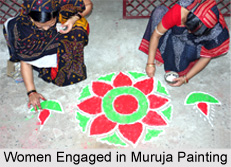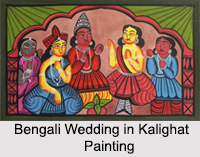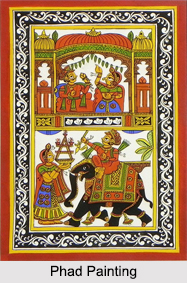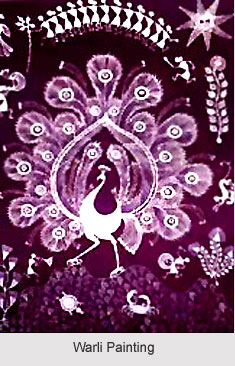 Kalighat temple in Kolkata is dedicated to the goddess Kali. The Kalighat Paintings are watercolor paintings done on mill-made paper by the scroll painters-cum-potters that migrated from rural Bengal to Kolkata in the 19th century. The styles of these paintings were characterized by broad sweeping brush lines, bold colors and simplification of forms. These paintings were sold to the devotees who visited the temple.
Kalighat temple in Kolkata is dedicated to the goddess Kali. The Kalighat Paintings are watercolor paintings done on mill-made paper by the scroll painters-cum-potters that migrated from rural Bengal to Kolkata in the 19th century. The styles of these paintings were characterized by broad sweeping brush lines, bold colors and simplification of forms. These paintings were sold to the devotees who visited the temple.
History of Kalighat Paintings
The Kalighat paintings were in existence from late 1830`s. During the late 18th and early 19th centuries, Indian artists moved to Kolkata (former Calcutta) with the breakdown of the Mughal patronage and miniature painters came from places like Patna and Murshidabad. They were settling in the city and making pictures for the British. The painters painted on subjects that would interest the rulers. They included different subjects such as Indian occupations, costumes, methods of transport, religious ceremonies, deities, birds, animals and flowers. The painters focused on the picturesque qualities of life around them. They drew pictures like a peasant with his bullock cart, a woman carrying water-pot, and shopkeepers with colorful wares. They painted on thin sheets of papers, using watercolors, and pencil or pen for drawing outlines and for shadings to suggest rounded forms, as these were the techniques favored by the British.
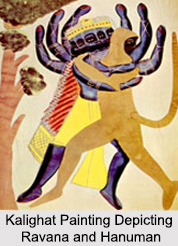 In addition to the Mughal painters, Indian artists belonging to different regions also migrated to Kolkata. The painters lived outside the city of Bengal - Bankura, Birbhum, Burdwan, Nadia and Hooghly. These painters were known as the village patuas or artist minstrels. They painted on scrolls illustrating pictures from the popular stories of the Ramayana and the Krishna Lila. They wandered from village to village, singing songs and showing their work. Their style of paintings was exactly opposite to that of the Mughal paintings with its free distortions, sharply linear rhythms and bold colors. These painters on arriving at Calcutta found too difficult to adjust to the British conditions.
In addition to the Mughal painters, Indian artists belonging to different regions also migrated to Kolkata. The painters lived outside the city of Bengal - Bankura, Birbhum, Burdwan, Nadia and Hooghly. These painters were known as the village patuas or artist minstrels. They painted on scrolls illustrating pictures from the popular stories of the Ramayana and the Krishna Lila. They wandered from village to village, singing songs and showing their work. Their style of paintings was exactly opposite to that of the Mughal paintings with its free distortions, sharply linear rhythms and bold colors. These painters on arriving at Calcutta found too difficult to adjust to the British conditions.
For them the Kalighat temple was an immediate scope and some of the painters settled near its neighborhood. They also began to adopt the new style found there and understood the merits of using watercolor. They painted on thin cheap paper and found out, that with a quick sweep of brush dramatic effects could be achieved with far less effort than by using the former medium, opaque gouache. Thus they began to draw bold and lively shapes and strong designs. Soon, Calcutta began to be a place that was opened for new visions. With its British and urban emphasis the focus of paintings became more secular and foreign subjects were also included in the paintings.
Depictions of Kalighat Paintings
In the middle of the 19th century Kalighat paintings were sold in large numbers to the pilgrims who visited the Kalighat temple. The painters painted on thin, fine hemp paper the pictures of Gods, which were depicted in gaudy bright colors. Dresses were depicted in scroll or spot patterns in silver and the edges of saris were emphasized with silver dashes. Necklaces and jewels were indicated with delicate silver lines.
Themes of Kalighat Paintings
The themes of the paintings also included Hindu Gods and Goddesses like Kali, Durga, Lakshmi, and Annapurna. The themes also included Sita-Rama, Radha-Krishna, exploits of Hanuman, Chaitanya Mahaprabhu and his disciples etc. Some other themes were an Englishman on an elephant shooting a tiger and jockeys engaged in horseracing etc. The Kalighat Paintings also included historic characters like Rani Lakshmibai, popular Duldul Horse of Imam Hussain of Karbala etc.
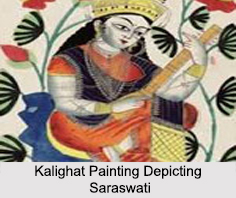 Modifications in Kalighat Paintings
Modifications in Kalighat Paintings
Later there were modifications in these paintings. Kalighat painters experimented with faint lithographed outlines to which they applied broad washes of color. They painted dancing-girls, courtesans, voluptuous women holding scarlet roses, women combing hair, nursing peacocks, courtesans eating pan or smoking nargila pipes. Moral principles were also affirmed by illustrating proverbs. They also painted pictures of snakes, fishes, prawns, cats, mice and jackals. Such paintings were in its zenith during 1865.
Revolution in Kalighat Paintings
The Kalighat Paintings became vastly expanded and the style had achieved new heights of rhythmical expression and during this period there was disgust with the modern life. The orthodox devotees blamed European influences for undermining the old Hindu attitudes to religion and ethics. They were against the new changes in paintings, which to them appeared as "Kaliyug". They disliked `the new Babu` or westernized man-about-town with his foppish dress, English shoes and curling` Albert hair-style`, named after the Prince Consort. They blamed western morals for the behavior of Calcutta men who kept `garden-houses`. They were against the idea of emancipation of women. Respecting the orthodox sentiments, the Kalighat painters responded and gradually new subjects entered their paintings. Besides painting courtesans, the painters started to draw satirical pictures like married women being beaten up by enraged husbands, in one picture musk-rats were painted holding a party in the house at night, while the master, like a night-moth, spends his nights away with courtesans etc.
The Kalighat painters portrayed day-to-day themes in their paintings to picture the moralizing bitterness in them. It was a time when the religious institutions were becoming lax and corrupt. Holy men were hypocritical and lived lives far from asceticism. These changes in subject matter were accompanied by changes in style. The day-to-day happenings of society provided with rich themes in their painting.

